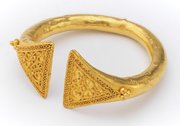
Planispheric Astrolabe
Museum of Islamic Art
- Title:
- Planispheric Astrolabe
- Production place:
- Iraq
- Date:
- 800 - 899
- Period:
- Abbasid
- Title:
- Planispheric Astrolabe
- Production place:
- Iraq
- Date:
- 800 - 899
- Period:
- Abbasid
- Material:
- Copper alloy
- Technique:
- Casting, Chiseling, Piercing, Assembling
- Dimensions:
- 9.8 × 8.5 × 2.3 cm
This is one of the earliest surviving astrolabes in known existence. Believed to have once come from a shipwreck, the instrument has suffered extensive corrosion from long term water damage; as a result, much of the astrolabe’s original detailing has been lost. At some point, the object was encased in an acrylic resin, presumably intended to further protect its already fragile state. This resin encasement now remains a permanent fixture. Intact early Abbasid astrolabes are rare, and yet the Abbasid capital of Baghdad was known to be the centre of scientific study and scholarship at the time. Instruments like this were used for exploration at a time when Islamic mathematicians and astronomers made considerable advancements towards scientific, medical, and astronomical discoveries.



